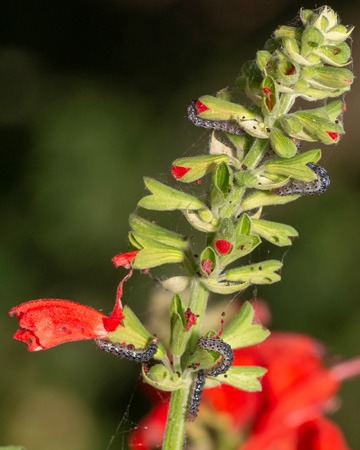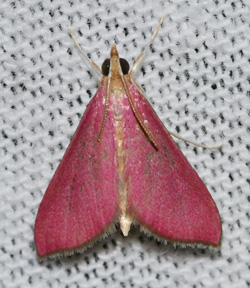Battles in the Salvia Garden: Pretty Southern Pink Moth

Southern Pink Moth (Pyrausta inornatalis) is diminutive and pretty, but it’s a powerful pest in Salvia gardens. As the common name indicates, it is primarily found in southern parts of the U.S. where the moth flies from March through November. Unfortunately, it is flitting into gardens in the Midwest and Mid-Atlantic and as far north as Oregon.
Oregon has become a leader in reporting on Southern Pink Moth (SPM). A 2020 map published in a pest alert by Oregon State University shows SPM in the following states: Alabama, Arkansas, Arizona, California, Delaware, Florida, Georgia, Illinois, Kansas, Kentucky, Louisiana, Maryland, Missouri, New Jersey, North Carolina, Oregon, South Carolina, Ohio, Oklahoma, Tennessee, Texas, and Virginia. According to a fact sheet by the Oregon Department of Agriculture, it may also be in New Mexico.
SPM currently isn’t present in Mendocino County where Flowers by the Sea Farm and Online Nursery is located. If it ever were to be found here, we would be mandated to sign a contract with the USDA outlining our pest scouting program and control measures and allowing for zero tolerance of the moth. FBTS is not transmitting this pest.
Plant Damage
Southern Pink Moth is so tiny that you might not notice it before observing the problems its equally miniscule caterpillars cause, such as buds shriveling and flowers dropping shortly after bloom.
Salvias appear to be the moth’s favorite host plants. However, according to the Oregon Department of Agriculture, it may be that basil is also a host. Like Salvia, basil is a member of the mint family.
Identification of Moth and Larvae
Lovely to look at, Southern Pink Moth has reddish pink forewings with bottom edges fringed in white. Its hindwings are brownish gray. The moth’s wingspan and body length both measure about a half inch.

SPM’s nearly translucent caterpillars (larvae) are also about a half-inch long. They have black dots and semi-transparent bodies that sometimes take on a pale shade of the flower on which they chew.
Signs of Larval Infestation
Similar to petunia and geranium budworms, SPM larvae harm flowers but not roots. You can see the tiny holes they bore into the bottoms and buds of Salvias.
Other signs of SPM infestation include larval excrement called frass and loose webs that support the pupae as they develop into larvae. Also, some gardeners report seeing the larvae moving inside flower buds.
Southern Pink Moth Control
Information is sparse about SPM and control methods. However, for Salvia gardeners who live where winter temperatures are chilly, here is one bit of encouraging information — cold may kill pupae. According to the Metro Master Gardeners’ newsletter of the Oregon State University Extension Service, it appears that temperatures of 20 degrees F or less “reduce the next season’s population.”
It seems logical that SPM larvae would be most active at night similar to the budworms of other flowers. For handpicking patrol, that likely means regularly checking your Salvias at dawn and dusk. The standard practice for dispatching individual budworms is to drop them in a container of soapy water. Another method for budworm removal that would probably work for exterminating SPM larvae is to place infected blossoms and foliage in a closed plastic bag to put in the trash. Never add infected plant material to compost heaps.
Many birds enjoy dining on budworms, so another logical guess is that they will help you with dawn and dusk demolition of SPM larvae. To invite lots of birds into your yard, create a welcoming environment containing trees, shrubs, birdbaths, seed feeders, and lots of flowers to attract tasty insects.
Speaking of insects, they also eat moth larvae. By minimizing pesticide use in your yard, you can maximize beneficial insects. Nevertheless, if pesticide is necessary, the OSU Extension Service recommends Bacillus thuringiensis (Bt), which only targets caterpillars.
To kill SPM larvae with Bt, you need to spray the pesticide on the plant parts that the caterpillars eat — the buds and blossoms. OSU warns that getting the timing right can be difficult and that “repeat applications may be needed.”
Questions and Advice
At FBTS, we work hard to control plant pests in the most ecofriendly ways possible. However, we are not entomologists. If you see Southern Pink Moth in your garden or observe other signs of their presence, we recommend contacting your local USDA Agricultural Extension Service office to report it and to obtain the most detailed information about controlling this pest.
Please feel free to contact us with any questions you may have about our plants and the best ways to grow them.
Photo by Bud Hensley

Comments
There are no comments yet.